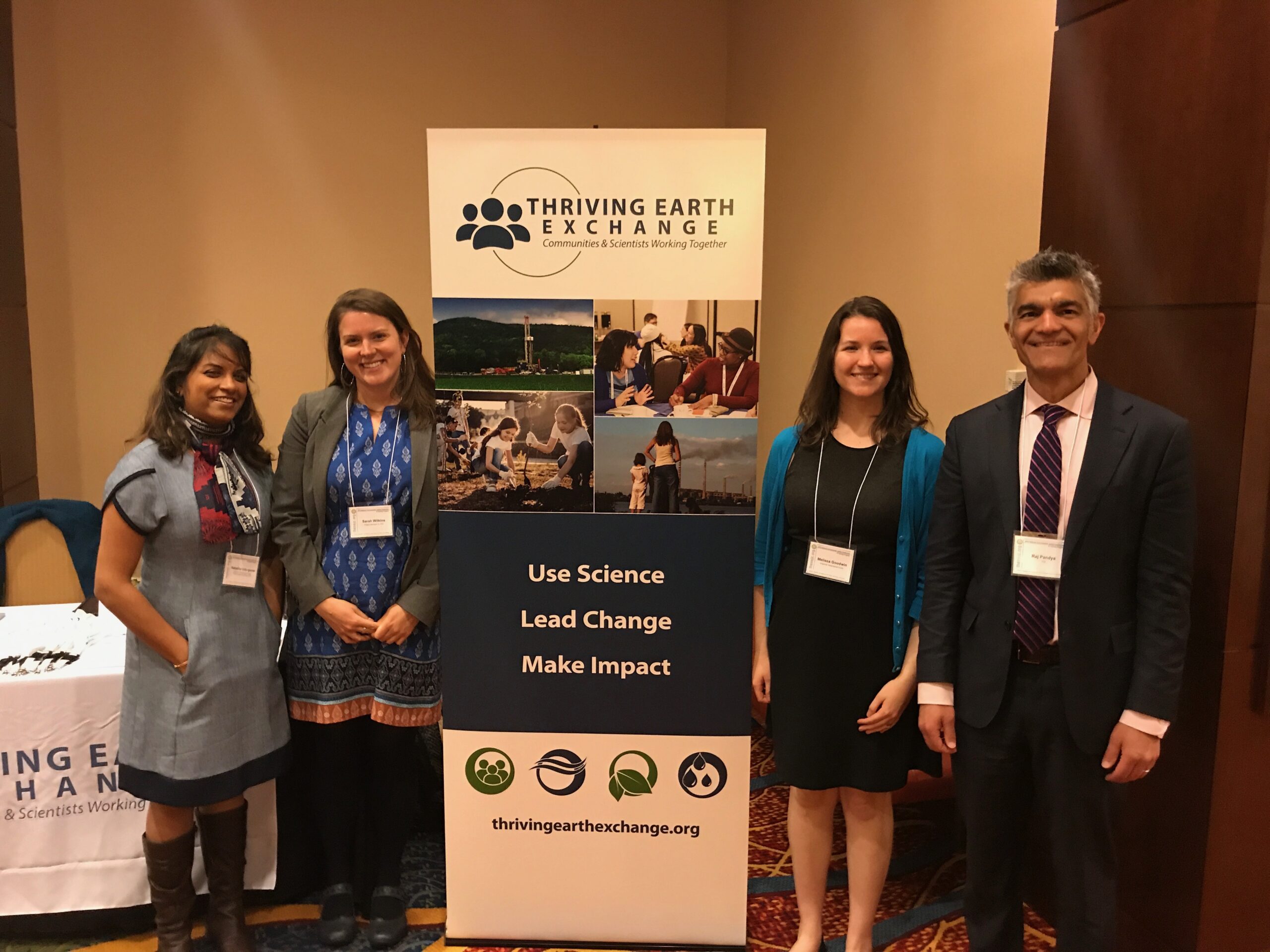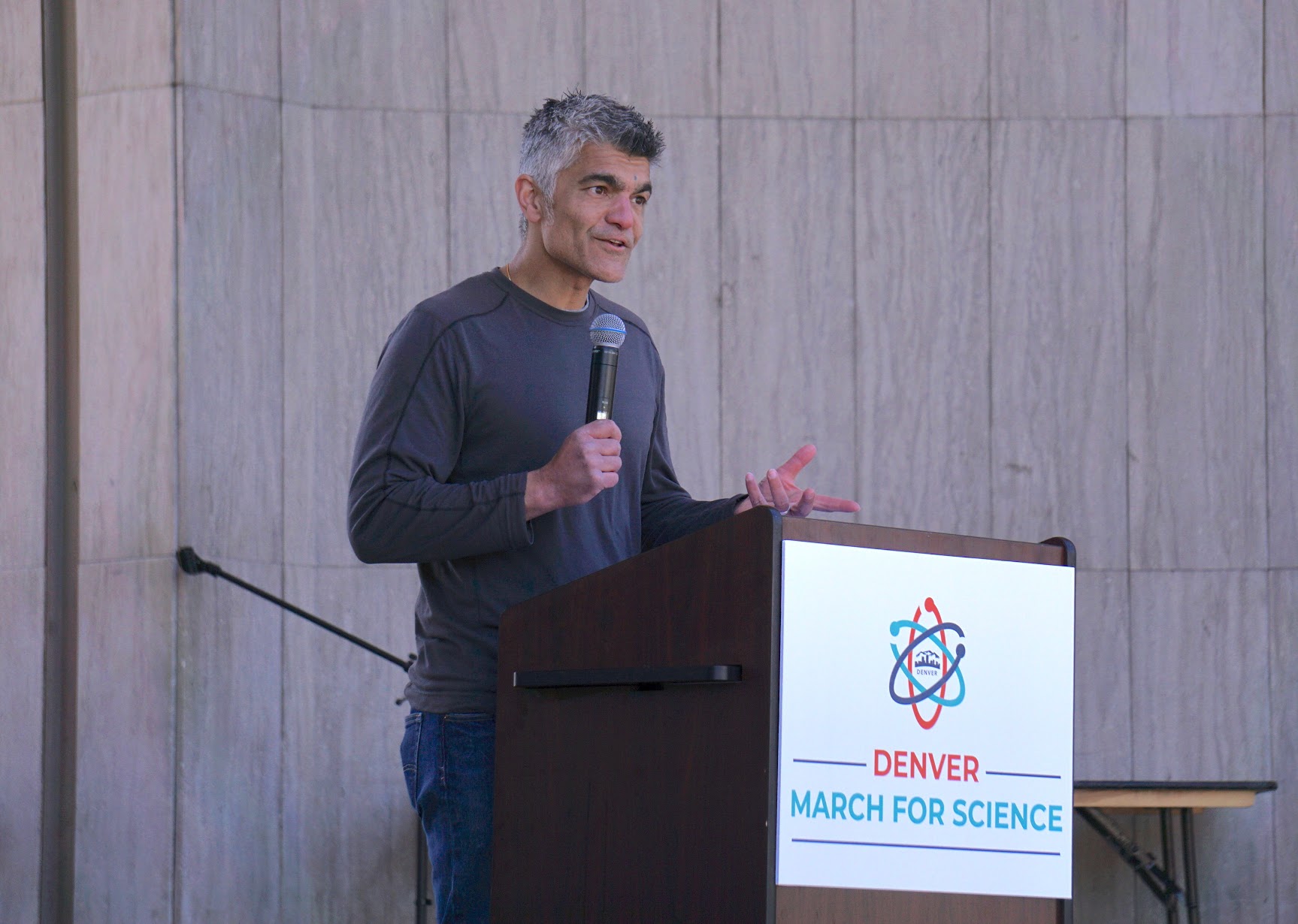Vice President of Community Science Raj Pandya started Thriving Earth Exchange in 2013.
_____
This month, I am leaving AGU and Thriving Earth Exchange. I wanted to use this last blog to say thank you, reflect on our accomplishments together, and talk about what is next.
First, thank you. Thriving Earth Exchange is a team sport. Our steering committee helped us set ambitious goals, our funders and AGU provided the resources to get us there, and our staff made sure we reached them. And our volunteers: over 1,000! Our volunteers turned the goal setting and support into concrete, on-the-ground benefits in over 250 communities to date. All of us participated together in developing and living up to a set of guiding principles that are the essence of Thriving Earth Exchange: the assertions that everyone should benefit, that the work should be co-created, and that science is a human right. Together, these principles define a participatory way of science that shares power, produces results, welcomes multiple knowledges, advances justice, and builds good relations. We learned, grew, and did good work together. Thank you.

Raj with other Thriving Earth Exchange team members at the 2018 National Environmental Justice Conference
In doing that work together, we had to be pragmatic. We had to navigate around barriers and rethink the way we’ve always done things[1]. We collaborated with volunteers because community-engaged science and community-based organizations aren’t well funded. We built and nurtured relationships in places and with people science had neglected. We worked toward justice to repair the harms that science had been part of. We strove for community outcomes to earn community trust and to show scientists that solutions can be as profound as discovery. We welcomed multiple knowledges and skills to be better people and to do better work.
While we accomplished a lot, and there is more to do. Our vision, that every community can engage in science around their priorities and on their terms, is still mostly ahead of us. Reaching that vision means growing Thriving Earth Exchange: working with new and more volunteers, communities, scientists, and partners; finding new ways to organize that work; and staying true to our core principles of mutual benefit, co-creation, and the right to science. Thriving Earth has a skilled and compassionate staff, strong partners and a new hub initiative, and AGU’s commitment to community science[2]. I am confident that that best is yet to come.

Raj speaking at the Denver March for Science
As if that wasn’t enough, there is something even bigger we can do. Remember the part about being pragmatic and working around barriers? What if, instead of having to work around the barriers, we took them down? Our next step, I think, is working together to change systems and scale up better approaches. For instance: we can get money directly into the hands of community-based organizations so they can engage scientists around their priorities[3]. We can prepare, support and reward scientists who a good at engaging with communities[4]. We can help our institutions be community allies[5]. The most vulnerable and the most harmed can be our first partners for investment and innovation. We can make scientific communities more welcoming, pathways into professional science more flexible, and science education more relevant to people who won’t be professional scientists. We can build systems that guide science more democratically and set priorities more justly[6]. All of this, I think, answers the question of what comes next for community science. Even better, all of it is already happening, so I think the next steps are mostly about connecting and growing what works.
That takes me to what is next for me. I am moving to to build systems and structures that prepare and support all of us as we work together toward just and sustainable[8] futures. I will work on education pathways and community programs that prepare us to be collaborative, compassionate, and principled leaders. I will work toward systems and structures that support us in being those kinds of leaders. In the world I am working toward, we grow up learning about sustainability and justice, it is embedded in everything we do together, and we have the power, intention, and skills to collaboratively redesign our infrastructure, politics, and economics around sustainability and justice. In short, we can and do work together so that every living being can thrive.
I don’t know, yet, how to do this[9], but I know that, at our best, we share. When we share knowledge, we learn more[10]. When we share resources, we thrive together. When we share grace—when we forgive—we grow together. What if we built systems around sharing? Can we build systems where landscapes are borrowed from, cared for, and given to the next generation? Can we build systems that grant nature rights and clarify the responsibilities that come with being human? Can we build systems that help our diversity take us forward? Can we build systems to help us learn humility, grace, connection, reciprocity as well as concrete skills? Can we build systems around respectful knowledge sharing, instead of intellectual property? Can we build learning environments that center justice and enable action? And can we do this in partnership with the generations before and after ours?
The answer is we can. We must. And we will. Together.
Finally, I want to close with art by Andrea Carlson. Follow this link to the fourth image. Written in the middle are the words “Give me knowledge so that I may have kindness for all.” When I think about Thriving Earth and what I want to leave behind and take forward, that is what I think of most of all.
Thank you for the opportunity to be part of this with you. Let’s stay connected, please[11], so we can explore new ways to work together.
– Raj Pandya

Group shot from a 2016 project launch workshop
[1] I have a friend who says when you do things because they’ve always been done that way, you might be perpetuating bias.
[2] Community Science is in the AGU strategic plan!
[3] Some examples: Frontline Resource Institute; Anthropocene Alliance
[4] Community Science Exchange
[5] Another friend calls this “accompaniment,” after Paul Farmer’s approach. I think the Community and College Partners Program and EPICn are examples.
[6] Center for Science and Policy Outcomes
[8] I always struggle with “just and sustainable” because I can’t imagine how injustice could be sustainable. And I also think “just and sustainable” is a little redundant, since living unsustainably is taking from those who come after us, disrespecting those who came before us, and being unfair to those we live with. At the same time, it’s important to say “just and sustainable” because green innovation can favor the elites and compound harm (another friend says the first signs of gentrification are Teslas and solar panels).
[9] Another friend – “if we knew what we were doing, we wouldn’t be growing.”
[10] Again, please stay connected – I know I’ll learn more from you and I hope I can give a little bit back, too.
[11] rajul.pandyaATgmail.com (replace “AT” with “@” if you aren’t a bot)

1 Comment
John W. FarringtonDec 21, 2023 at 2:14 PM
Congratulations and thank you to Raj for being a visionary and a team builder. Your dedication is inspiring! Best wishes for continued success. John